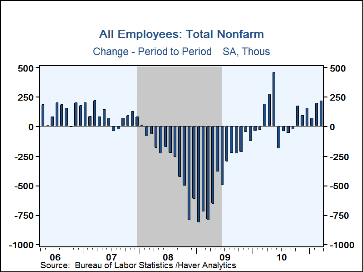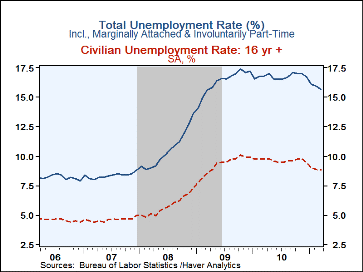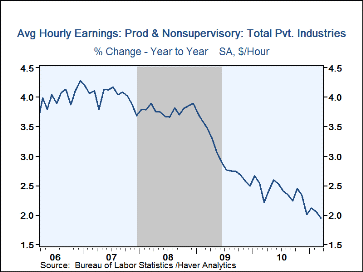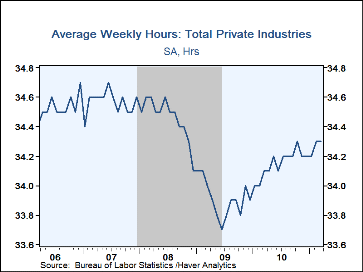 Global| Apr 01 2011
Global| Apr 01 2011U.S. Payroll Employment Gain Is Healthy And Jobless Rate Falls
by:Tom Moeller
|in:Economy in Brief
Summary
The U.S. job market clearly recovered from depressing winter weather. Nonfarm payrolls increased 216,000 last month and added to a 194,000 February gain, initially reported as 192,000. The January gain also was revised up slightly to [...]
The U.S. job market clearly recovered from depressing winter weather. Nonfarm payrolls increased 216,000 last month and added to a 194,000 February gain, initially reported as 192,000. The January gain also was revised up slightly to 68,000 from 63,000. The latest gain exceeded Consensus expectations for a 175,000 increase. Another sign of improvement was the fall in the unemployment rate to 8.8%. That was the lowest level since March 2009 and compared to expectations of 8.9%
From the establishment jobs survey, the 194,000 increase was driven by a 199,000 increase in private service sector employment. The gain reflected a 78,000 gain in professional & business services (3.2% y/y), a 45,000 increase (2.2% y/y) in education and health and a 37,000 rise (1.5% y/y) in leisure & hospitality. Temporary help services jobs again were firm and posted a 28,800 (12.5% y/y) increase. Government jobs fell another 14,000 (-1.6% y/y) as budget shortfalls continued to force job cutbacks. Lower local government payrolls accounted for all of last month's total decline and were off 15,000 (-1.8% y/y).
The household survey indicated a decline in the unemployment rate to 8.8%, the fourth consecutive monthly decline and it compared to the high of 10.1% in October 2009. The overall unemployment rate, including those involuntarily working part-time, slipped to 15.7%. Employment increased 291,000 (0.7% y/y) while the civilian labor force rose 160,000 (-0.3% y/y). The labor force participation rate remained at its recent low of 64.2% versus the high of 67.1% roughly ten years ago. The average duration of unemployment jumped again, last month to a record 39.0 weeks and the number of those unemployed for more than 27 weeks rose after two months of decline (-6.1% y/y).
The private sector workweek in March remained stable m/m at 34.3. For Q1'11, the index of aggregate hours worked (employment times hours) rose 0.5% (AR) from Q4'10.
The diffusion index of private sector employment, which measures the breadth of job increase, fell to 62.4% and retraced most of its February increase. The factory sector index also fell to 63.0%, its lowest since December.
Average hourly earnings slipped 0.1% last month (2.0% y/y) and reversed the February increase. A 0.2% increase had been expected. The unchanged level of earnings (2.1% y/y) in the goods producing sector was countered by a 0.2% slip (+1.9% y/y) in services.
The figures referenced above are available in Haver's USECON database. Additional detail can be found in the LABOR and in the EMPL databases. The expectation figures are from Action Economics and are in the AS1REPNA database.
| Employment: (M/M Chg., 000s) | Mar | Feb | Jan | Y/Y | 2010 | 2009 | 2008 |
|---|---|---|---|---|---|---|---|
| Payroll Employment | 216 | 194 | 68 | 1.0% | -0.7% | -4.4% | -0.6% |
| Previous | -- | 192 | 63 | -- | -0.5% | -4.3% | -0.6% |
| Manufacturing | 17 | 32 | 53 | 1.7% | -2.7% | -11.6% | -3.4% |
| Construction | -1 | 37 | -20 | -0.6 | -8.1% | -16.0% | -6.1% |
| Private Service Producing | 199 | 167 | 56 | 1.6% | -0.1% | -3.5% | -0.2% |
| Government | -14 | -46 | -26 | -1.6 | -0.3% | 0.3% | 1.3% |
| Average Weekly Hours | 34.3 | 34.3 | 34.2 | 34.1 (Mar.'10) |
34.2 | 33.9 | 34.5 |
| Average Hourly Earnings | -0.1% | 0.1% | 0.4% | 2.0% | 2.4% | 3.0% | 3.8% |
| Unemployment Rate (%) | 8.8 | 8.9 | 9.0 | 9.7 (Mar.'10) |
9.6 | 9.3 | 5.8 |
Tom Moeller
AuthorMore in Author Profile »Prior to joining Haver Analytics in 2000, Mr. Moeller worked as the Economist at Chancellor Capital Management from 1985 to 1999. There, he developed comprehensive economic forecasts and interpreted economic data for equity and fixed income portfolio managers. Also at Chancellor, Mr. Moeller worked as an equity analyst and was responsible for researching and rating companies in the economically sensitive automobile and housing industries for investment in Chancellor’s equity portfolio. Prior to joining Chancellor, Mr. Moeller was an Economist at Citibank from 1979 to 1984. He also analyzed pricing behavior in the metals industry for the Council on Wage and Price Stability in Washington, D.C. In 1999, Mr. Moeller received the award for most accurate forecast from the Forecasters' Club of New York. From 1990 to 1992 he was President of the New York Association for Business Economists. Mr. Moeller earned an M.B.A. in Finance from Fordham University, where he graduated in 1987. He holds a Bachelor of Arts in Economics from George Washington University.










